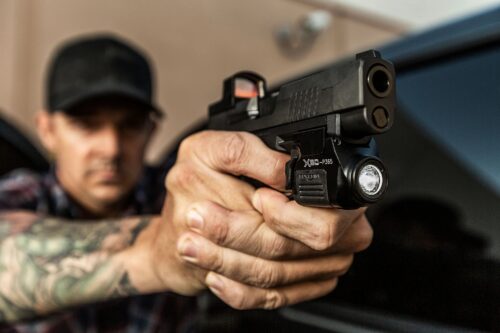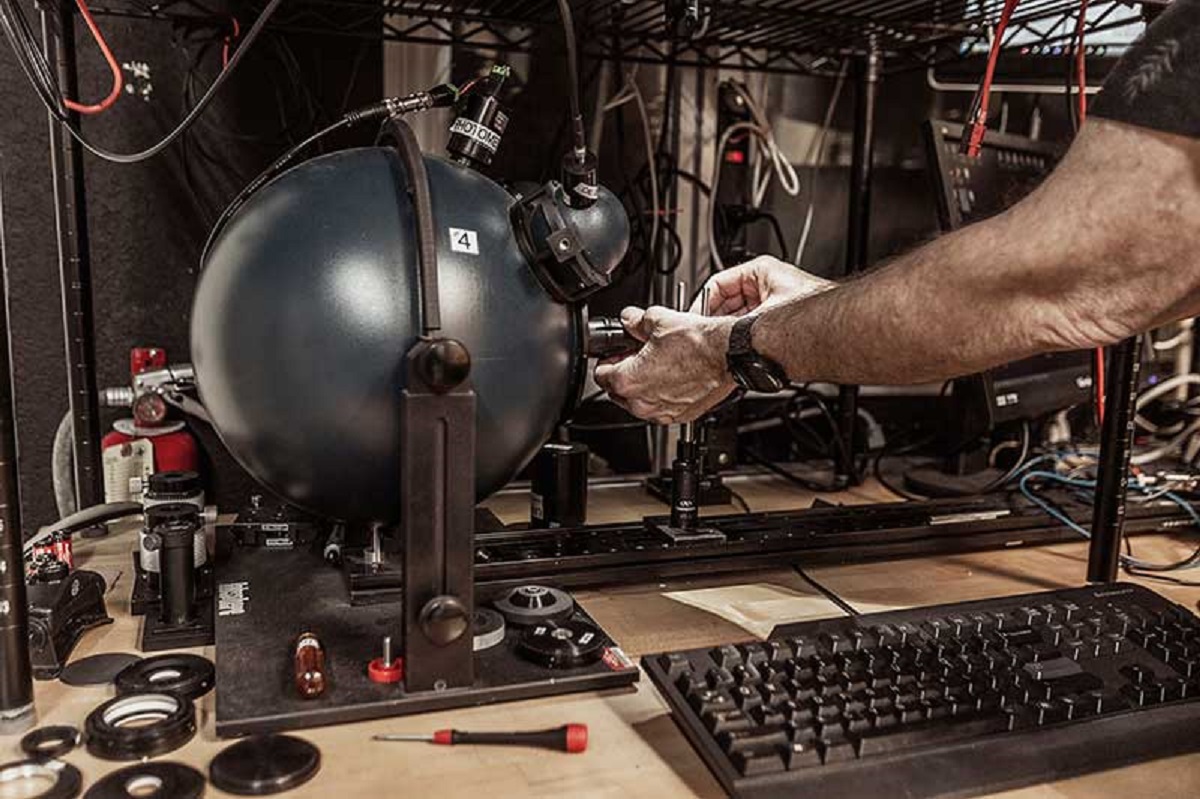Flashlight lumen testing at SureFire. Lumens are measured using a device called an integrating sphere. Integrating spheres are optical components consisting of a hollow spherical cavity with a white reflective coating on the inside. Pointed into the sphere, all of the flashlight’s emitted light is collected and measured by a sensor inside the sphere.
If you are in the market for a new flashlight, you may have come across the term ANSI/PLATO FL 1 Standard on some product packaging or websites. But you may wonder what exactly does it mean and why is it important? Let’s take a take a look at the basics of this industry standard and how it can help you make an informed decision when purchasing a flashlight.
The ANSI/PLATO FL 1 Standard is a voluntary product standard developed by the Portable Lights American Trade Organization (PLATO), an association of leading manufacturers in the portable lighting industry. It was first published in 2016 as a revision of the previous American National Standards Institute (ANSI) ANSI/NEMA FL 1 Standard and updated again in 2019 to include area lights. The standard specifies the testing and reporting methods for portable lighting products that emit directional light, such as hand-held flashlights, weapon lights, headlamps, bicycle lights and spotlights.
The ANSI/PLATO FL 1 Standard provides a common language for comparing and evaluating flashlights based on objective and verifiable data. It helps consumers make informed decisions when choosing a flashlight that suits their specific needs. The standard aims to improve portable light quality and packaging transparency, by providing clear and consistent performance claims that consumers and retailers can trust and compare.
Performance Parameters
The ANSI/PLATO FL 1 Standard covers six key performance parameters: light output, beam distance, peak beam intensity, run time, impact resistance and water resistance:
Light output: Light output is the total amount of light emitted by the flashlight in lumens. It is measured at 30 seconds after turning on the light with fresh batteries. It is measured using an integrating sphere, which captures and measures all the light from the flashlight.
Beam distance: Beam distance is the maximum distance at which the flashlight can produce a useful amount of light, defined as 0.25 lux (equivalent to the light from a full moon “on a clear night in an open field”). It is measured in meters using a light meter and a target at a fixed distance from the flashlight.
Peak beam intensity: Peak beam intensity is the maximum brightness of the flashlight’s beam at its center, measured in candela (cd). It is calculated by multiplying the light output in lumens by the beam angle in steradians. Peak beam intensity does not necessarily translate to perceived brightness since human vision is non-linear in nature.
Run time: Run time is the duration of time that the flashlight can operate until its light output drops to 10% of its initial value. Measurement starts 30 seconds after light is turned on and the light output is measured every 15 minutes. Run time is measured in hours and minutes using a continuous discharge test with fresh batteries. Run time is considered one of the most significant limitations of the standard since not all flashlights and batteries operate in the same manner.
Impact resistance: Impact resistance is the ability of the flashlight to withstand drops from a certain height without damage (cracks or breaks) or loss of function. It is measured in meters using a drop test with six drops on each of six orientations (top, bottom, front, back, left, right). It must meet a minimum of one meter to receive this rating.
Water resistance: Water resistance is the ability of the flashlight to prevent water ingress and function normally when exposed to water. It is based on the ANSI/IEC 60529 Standard (also known as the IP Code) and measured using three ratings: IPX4 (splash resistant), IPX7 (submersible up to 1 meter for 30 minutes), and IPX8 (submersible for 1 meter or greater for manufacturer specified depth and time).

Each parameter has a corresponding icon that manufacturers can use on their product packaging or marketing materials, as long as they comply with the testing and reporting methods of the standard. The icons also indicate the units of measurement and the testing conditions for each parameter. For example, the light output icon shows the total amount of light emitted by the product in lumens, measured at 30 seconds after turning on the light with fresh batteries. The run time icon shows the duration of time until the light output drops to 10% of the initial value, measured in hours.
By using the ANSI/PLATO FL 1 Standard icons, manufacturers can communicate their product performance in a simple and accurate way, while consumers can easily compare different products based on their needs and preferences. The standard also helps to prevent false or misleading claims that may confuse or deceive customers. However, not all manufacturers use or follow the standard correctly, so it is important to check the credibility and reputation of the brand before buying a flashlight. PLATO provides industry oversight and independent third-party testing to ensure that portable lighting products meet or exceed the standard.
The ANSI/PLATO FL 1 Standard performance is a valuable indicator of how well a flashlight performs in terms of light output, runtime, beam distance, peak beam intensity, and impact and water resistance. However, it should not be the sole criterion to base one’s choice on when buying a flashlight. I recommend that you do some research and comparison of different models and features before selecting a flashlight in order to get the one that best suits your needs. If at all possible, try before you buy.
*The views and opinions expressed on this website are solely those of the original authors and contributors. These views and opinions do not necessarily represent those of Spotter Up Magazine, the administrative staff, and/or any/all contributors to this site.
